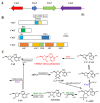Research Progress on Cordycepin Synthesis and Methods for Enhancement of Cordycepin Production in Cordyceps militaris
- PMID: 35200422
- PMCID: PMC8869658
- DOI: 10.3390/bioengineering9020069
Research Progress on Cordycepin Synthesis and Methods for Enhancement of Cordycepin Production in Cordyceps militaris
Abstract
C. militaris is an insect-born fungus that belongs to Ascomycota and Cordyceps. It has a variety of biological activities that can be applied in medicine, health-care products, cosmeceuticals and other fields. Cordycepin (COR) is one of the major bioactive components identified from C. militaris. Thus, C. militaris and COR have attracted extensive attention. In this study, chemical synthetic methods and the biosynthesis pathway of COR were reviewed. As commercially COR was mainly isolated from C. militaris fermentation, the optimizations for liquid and solid fermentation and genetic modifications of C. militaris to increase COR content were also summarized. Moreover, the research progress of genetic modifications of C. militaris and methods for separation and purification COR were introduced. Finally, the existing problems and future research direction of C. militaris were discussed. This study provides a reference for the production of COR in the future.
Keywords: Cordyceps militaris; biosynthesis; cordycepin; genetic modification.
Conflict of interest statement
The authors declare no conflict of interest.
Figures




References
-
- Wu F., Zhou L.W., Yang Z.L., Bau T., Dai Y.C. Resource diversity of Chinese macrofungi: Edible, medicinal and poisonous species. Fungal Divers. 2019;98:1–76. doi: 10.1007/s13225-019-00432-7. - DOI
-
- Tian L.H., Hu B., Zhou H., Zhang W.M., Qu L.H., Chen Y.Q. Molecular phylogeny of the entomopathogenic fungi of the genus Cordyceps (Ascomycota: Clavicipitaceae) and its evolutionary implications. J. Syst. Evol. 2010;6:47–56. doi: 10.1111/j.1759-6831.2010.00100.x. - DOI
Publication types
Grants and funding
- 20192ACBL20012/National Natural Science Foundation of Jiangxi Province
- 20202BDH80007/National Natural Science Foundation of Jiangxi Province
- 20212BA205001/National Natural Science Foundation of Jiangxi Province
- GJJ201141/Science and Technology Research Project of Jiangxi Provincial Department of Education
- 2019QNBJRC004/the youth talent support program of Jiangxi Science & Technology Normal University
LinkOut - more resources
Full Text Sources
Other Literature Sources
Research Materials

